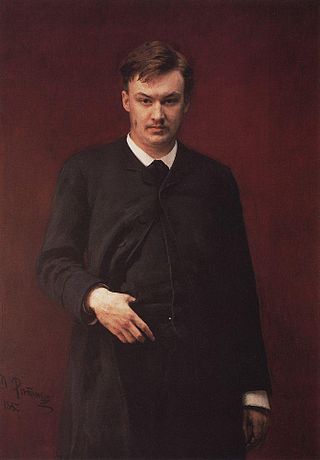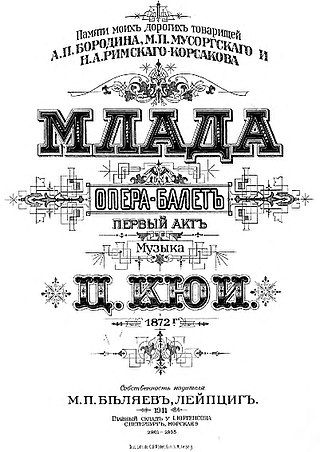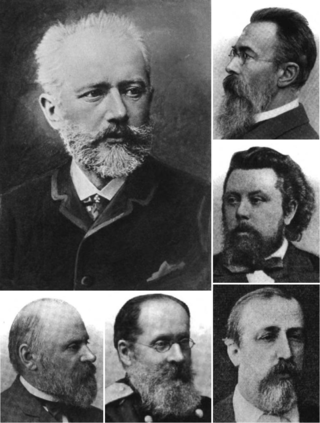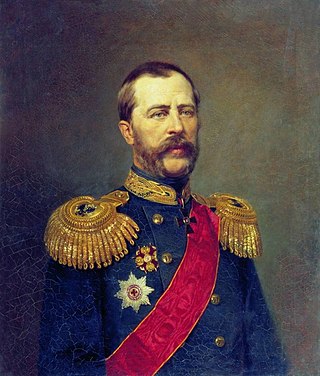
Nikolai Andreyevich Rimsky-Korsakov was a Russian composer, a member of the group of composers known as The Five. He was a master of orchestration. His best-known orchestral compositions—Capriccio Espagnol, the Russian Easter Festival Overture, and the symphonic suite Scheherazade—are staples of the classical music repertoire, along with suites and excerpts from some of his fifteen operas. Scheherazade is an example of his frequent use of fairy-tale and folk subjects.

Alexander Konstantinovich Glazunov was a Russian composer, music teacher, and conductor of the late Russian Romantic period. He was director of the Saint Petersburg Conservatory between 1905 and 1928 and was instrumental in the reorganization of the institute into the Petrograd Conservatory, then the Leningrad Conservatory, following the Bolshevik Revolution. He continued as head of the Conservatory until 1930, though he had left the Soviet Union in 1928 and did not return. The best-known student under his tenure during the early Soviet years was Dmitri Shostakovich.

Anton Stepanovich Arensky was a Russian composer of Romantic classical music, a pianist and a professor of music.

The N. A. Rimsky-Korsakov Saint Petersburg State Conservatory is a school of music in Saint Petersburg, Russia. In 2004, the conservatory had around 275 faculty members and 1,400 students.

Mlada was a project conceived in 1870 by Stepan Gedeonov (1816–1878), director of the Saint Petersburg Imperial Theatres, originally envisioned as a ballet to be composed by Aleksandr Serov with choreography by Marius Petipa.

Novodevichy Cemetery in Saint Petersburg is a historic cemetery in the south-west part of the city near the Moscow Triumphal Gate. The cemetery is named after the historical Resurrection (Novodevichy) Convent. In the 19th century it was the second most prestigious cemetery after the Tikhvin Cemetery in the Alexander Nevsky Monastery.

Nadezhda Ivanovna Zabela-Vrubel was an Imperial Russian opera singer, the niece of the Russian sculptor Parmen Zabela. Vocally, she is best described as a coloratura soprano, with a particularly high tessitura.

In mid- to late-19th-century Russia, Pyotr Ilyich Tchaikovsky and a group of composers known as The Five had differing opinions as to whether Russian classical music should be composed following Western or native practices. Tchaikovsky wanted to write professional compositions of such quality that they would stand up to Western scrutiny and thus transcend national barriers, yet remain distinctively Russian in melody, rhythm and other compositional characteristics. The Five, made up of composers Mily Balakirev, Alexander Borodin, César Cui, Modest Mussorgsky, and Nikolai Rimsky-Korsakov, sought to produce a specifically Russian kind of art music, rather than one that imitated older European music or relied on European-style conservatory training. While Tchaikovsky himself used folk songs in some of his works, for the most part he tried to follow Western practices of composition, especially in terms of tonality and tonal progression. Also, unlike Tchaikovsky, none of The Five were academically trained in composition; in fact, their leader, Balakirev, considered academicism a threat to musical imagination. Along with critic Vladimir Stasov, who supported The Five, Balakirev attacked relentlessly both the Saint Petersburg Conservatory, from which Tchaikovsky had graduated, and its founder Anton Rubinstein, orally and in print.

Nikolai Rimsky-Korsakov composed his Symphony No. 1 in E minor, Op. 1, between 1861 and 1865 under the guidance of Mily Balakirev. Balakirev also premiered the work at a concert of the Free Music School in December 1865. Rimsky-Korsakov revised the work in 1884.
Nikolai Rimsky-Korsakov wrote his Fantasia on Serbian Themes, Op. 6, in 1867. Mily Balakirev conducted the first performed of this piece in May of that year. It is also known as the Serbian Fantasy.
Alexander Vyacheslavovich Ossovsky was a Russian and Soviet musicologist, music critic and professor at Saint Petersburg Conservatory, pupil of Nikolai Rimsky-Korsakov, and friend of Sergei Rachmaninoff, Alexander Siloti and Nikolai Tcherepnin.
The Belyayev circle was a society of Russian musicians who met in Saint Petersburg, Russia between 1885 and 1908, and whose members included Nikolai Rimsky-Korsakov, Alexander Glazunov, Vladimir Stasov, Anatoly Lyadov, Alexander Ossovsky, Witold Maliszewski, Nikolai Tcherepnin, Nikolay Sokolov, Alexander Winkler among others. The circle was named after Mitrofan Belyayev, a timber merchant and amateur musician who became a music philanthropist and publisher after hearing the music of the teenage Glazunov.

Voin Andreyevich Rimsky-Korsakov was a Russian navigator, hydrographer and geographer. He was an elder brother of composer and conductor Nikolai Rimsky-Korsakov.

Ivan Nikolajevich Rimsky-Korsakov, né Korsav was a Russian courtier and lover of Catherine the Great from 1778 to 1779.

Pyotr Ilyich Tchaikovsky's relations with the group of composers known as the Belyayev circle, which lasted from 1887 until Tchaikovsky's death in 1893, influenced all of their music and briefly helped shape the next generation of Russian composers. This group was named after timber merchant Mitrofan Belyayev, an amateur musician who became an influential music patron and publisher after he had taken an interest in Alexander Glazunov's work. By 1887, Tchaikovsky was firmly established as one of the leading composers in Russia. A favorite of Tsar Alexander III, he was widely regarded as a national treasure. He was in demand as a guest conductor in Russia and Western Europe, and in 1890 visited the United States in the same capacity. By contrast, the fortunes of the nationalistic group of composers known as The Five, which preceded the Belyayev circle, had waned, and the group had long since dispersed; of its members, only Nikolai Rimsky-Korsakov remained fully active as a composer. Now a professor of musical composition and orchestration at the Saint Petersburg Conservatory, Rimsky-Korsakov had become a firm believer in the Western-based compositional training that had been once frowned upon by the group.

Saint Petersburg Philharmonia, officially the Saint Petersburg Academic Philharmonia Named After D. D. Shostakovich, is a music society located in Saint Petersburg, Russia, and is the name of the building where it is housed. Also there is another one building of Saint Petersburg Philharmonic Society: Malii Zal. The location of the Small Hall is in the city centre. The society now hosts two symphony orchestras: Saint Petersburg Philharmonic Orchestra and Saint Petersburg Academic Symphony Orchestra. The venue is named after Dmitri Shostakovich.

The Nikolai Rimsky-Korsakov Memorial Museum-Apartment is a branch of the St. Petersburg State Museum of Theatre and Music.
The Symphony in E-flat, Op. 1, is the first published work composed by Igor Stravinsky during his apprenticeship with Nikolai Rimsky-Korsakov. It is also his first composition for orchestra. Of classical structure, it is broadly influenced by Rimsky-Korsakov, Glazunov, Tchaikovsky and Wagner. It was composed in 1905–1907 and revised in 1913. It lasts for about forty minutes.

Pargolovo is a municipal settlement in the Vyborgsky District of Saint Petersburg, Russia. Until the late 20th century, it was the city's northern suburb. The name derives from Parkola, a Karelian placename. Its population in 2010 was 15,852.

Vladimir Ivanovich Belsky was a Russian poet and opera librettist, known for his collaborations with the composer Nikolai Rimsky-Korsakov (1844-1908).

















